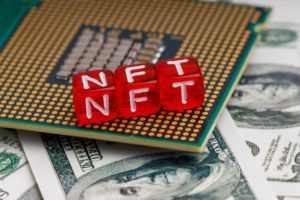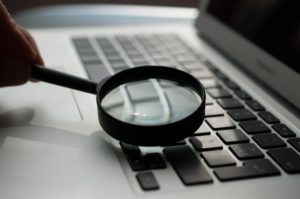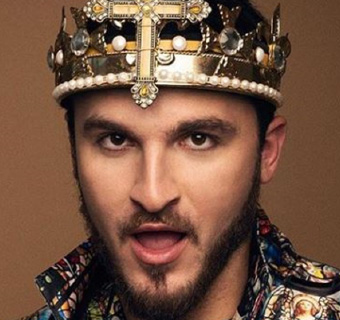Table of Contents
With the craze surrounding NFTs, we are presented with a learning curve. In order to have a handle on this new and exciting topic, we have to wrap our heads around a whole new technology and many important NFT key terms.
Maybe you have some basic knowledge, or even just a friend who talks about it a lot that has given you a leg up in learning. But that is not always the case, and many people need to resort to some online research to learn what is being talked about in the NFT space.
That’s where we come in! Today we are going to give an explanation of NFTs, what they are used for (or maybe what they could be used for down the road), and some important key terms that you need to have in your vernacular to stay up to speed and participate in the world of NFTs.
What is an NFT?
Photo by Andrey Metelev on Unsplash
The most common NFT key term used to talk about NFTs is, well, NFT, which stands for non-fungible token. This means they are unique items that can’t be swapped out. As the name suggests, NFTs aren’t fungible – a word alone that is not in our everyday uses before NFTs. The definition of fungible is: being something of such a nature that one part or quantity may be replaced by another equal part or quantity in paying a debt or settling an account.
So, a dollar, or even a bitcoin, is fungible by the characteristic that you can replace a dollar with another one and use it for the same purpose. A non-fungible item, such as a piece of original art, cannot be swapped for another piece of art that represents the same characteristics as the original one – it’s unique.
NFTs are a digital form of this; they can certainly represent digital art in a similar manner as traditional art (digital art is where NFTs have been popularized). However, NFT technology can also be used in many other forms too.
One of the NFT key terms you will hear in almost every conversation is “blockchain”. This is because NFTs live on the blockchain, which is a network where data of all types is stored and does not rely on any one establishment, instead it is secured by many, many computers and ledgers around the world to maintain its security and accuracy.
What else can be an NFT besides digital art?
Due to the nature of NFT technology, literally any original item can be represented with an NFT. As mentioned, you can purchase a piece of digital art that will be delivered to you electronically and will come with a token that is registered on the blockchain verifying you as the owner.
NFTs can also represent other digital items such as music or video games – they are even being used to represent ownership of physical items, such as trading cards or other collectibles. Any item can be registered on the blockchain and attached to an NFT to establish the owner
What are some other NFT uses?
Non-fungible tokens are a way of creating and verifying any data on the blockchain. This means that while art and collectibles have popularized this technology, it may also be used for many other applications in the future.
Some other applications being explored that could someday come into popular use are:
- Medical records
- Insurance certificates
- Personal identification
- Home sales
- Event and Travel tickets
- And so much more
Interested in learning more details about NFTs and how their applications? Check out some of the best NFT YouTube channels here.
What terms do I need to know to understand what is going on when I hear about NFTs?
Photo by Agence Olloweb on Unsplash
There are many terms that are used in NFTs, a lot of which overlap with cryptocurrencies or blockchain lingo as they inhabit the same space and use the same general technologies.
Here we have rounded up some of the NFT key terms you will want to be knowledgeable about to feel in the know.
Drop
This means to release a new NFT project. The word drop is commonly used when referring to the release of things like music or software, too. In the NFT space, the word drop almost always means that the project is ready to be purchased, traded, and begin being active in the marketplace.
Minting
For an item to become an NFT it needs to be minted. This is the process of registering an item on the blockchain. There are many tools and software to aid in this process, but what happens is that someone transfers a digital file from their computer or digital wallet to the decentralized blockchain. This can be music, a picture, or anything else. This is one of the most crucial NFT key terms for understanding the legal and official creation of items.
Projects
When a particular artist or owner creates an NFT, that is then called a project in NFT key terms. This is most commonly used when a creator is releasing a collection of related NFTs, such as the very popular CryptoPunks or Bored Ape Yacht Club.
Looking to run an epic influencer marketing campaign with NFTs? NeoReach has the best experience in creating viral campaigns that convert on social media. Sign up here!
DeFi
One of the many NFT key terms that overlap with cryptocurrencies and blockchain as a whole, DeFi is short for decentralized finance. This is a movement in technology where assets are not stored in one location (such as a bank) and instead kept on secure ledgers distributed to thousands and thousands of computers all talking to each other on the same network keeping data secure.
Gas
This is the NFT key term for the charge you incur when purchasing an NFT. Gas is not the price of an NFT, but rather a transaction fee for trading with NFTs. They can fluctuate based on the size of the item being traded and the traffic on the blockchain at the time of the trading.
Metaverse
Photo by Mo on Unsplash
Certainly one of the more confusing NFT key terms is Metaverse. What is it actually? Well, there are many different interpretations of the metaverse and what can be included in it, we will just address how it is referred to in the NFT space.
In this sense and simply put, the Metaverse is a virtual reality game world where users can use NFTs to trade with each other inside the virtual world. There are a few of them that exist, such as Decentraland and The Sandbox, but they are built on blockchains and operate with and through NFT technology.
Want to read more about NFTs and the Metaverse? Read our report here
Smart Contracts
These are programs within the digital blocks in the blockchain network that are designed to execute automatically when certain criteria are met. They are an important element of what makes blockchain technology perform in the way it does.
Metadata
This is an NFT key term used to describe data sources that provide information about other data sources. You can usually find descriptive information such as the size, structure, format, reference, or other important information about the target data before getting to the content itself.
Airdrop
We have heard this term from Apple users to transfer data wirelessly. In NFTs, it refers to sending NFTs to other users for free on the blockchain.
Burn
This NFT key term means what you’d expect, but there is one distinct difference: burning an NFT does eliminate it from the blockchain. Although there is no way to fully destroy an NFT once it has been minted (another NFT key term we looked at earlier), burning sends the NFT to a digital wallet address that is not owned by anybody, effectively destroying the NFT.
Delist
This is the action of removing an NFT from the marketplace, as is often the case when a copyright issue has been brought up. Sometimes they are relisted, other times not, making for a disadvantaged spot for the holder of that NFT.
This is by no means an exhaustive list, but it does cover a lot of the terms we hear thrown around. Without a basic understanding of how NFT key terms are used in context, it would be quite confusing to be in the room – something that discourages many from joining the space.
The landscape of NFTs and blockchain technology is constantly changing, and with it, new terms pop up regularly. Staying on top of the movements of the NFT economy and the lingo being used is an exciting space.
Want to learn about launching your own NFT? Here is a complete guide!


























